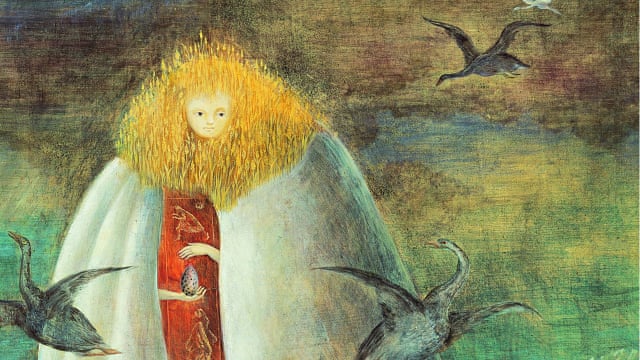
Leonora Carrington, The Giantess (The Guardian of the Egg) c.1947
The Grandmother Project is an online archive where people can share stories about the women who came before them.
On first glance, the word “grandmother” might immediately make you think “boring,” or at least “old-fashioned.” The word certainly conjures the stereotype of a hunched-shouldered woman in a rocking chair, a gray bun on her head, the fire lit at her side. At the same time, grandmothers uphold a fundamental role in most cultures’ legend making. They are the source of our beloved fairy tales. As storytellers, they are often depicted with small children sitting around them in rapt attention as the rocking chair sways ever so slightly.
This picture is not everyone’s image of a grandmother, of course, and I’m sure it is not the picture of your actual grandmother, the one who gave birth to your mother or father, the one you may or may not have known closely or even at all. The mythical grandmother means something else entirely; she is more universal Mother symbol than she is flesh-and-blood human being.
The Grandmother Project aims to magnify those very human qualities of grandmothers. It is an online archive where submitters can post stories about their grandmothers in written, audio, or video form. Some of these women are still living, many of them are not. By far the vast majority have never had a story about them told to a wider public. The lives of women are particularly invisible, as opposed to the lives of men, because throughout history a woman’s place has traditionally revolved around the home—that private sphere where everything “everyday” gets done but in which no one is really all that interested.
In the summer of 2015, I sat with my grandmother Lucille Reed at her home in Illinois and asked her questions about her life, recording what she had to say on my iPhone. I had started researching the lives of two women for a book project: my grandmother as well as my great-grandmother, Edna Hellman, who lived from 1884 to 1982 in New York City. Soon I began to think of what it would be like to gather grandmother stories from people everywhere, and to establish an archive of stories that could be read, listened to, and shared.
The women these stories are about lived in different times and places, yet if you look closely, those times and places are not all that different from our present moment in many ways. My great-grandmother Edna declared in an interview with my father in 1979, “I was brought up ridiculously, and so many of my friends the same,” when speaking about the way girls were raised at the turn of the twentieth century. Now that we are well into the twenty-first, can we honestly say that men and women are treated equally? Without listening to these women’s stories and saving them for future generations, the chance to acknowledge the differences, and especially the astonishing similarities, vanishes.
This archive establishes a space in which the stories of women—of all backgrounds, ages, and ethnicities—are amplified. By skipping one or more generations backward in time, we create enough distance to see the past clearly. Maybe we can see enough to understand what to do next.
—Anne Hellman

Anne Hellman is a writer living in Brooklyn, NY. She has published stories in Catapult, Guestbook, and the Ladyfest Anthology, among others. She is the author of Design Brooklyn: Renovation, Restoration, Innovation, Industry (Abrams, 2013).

